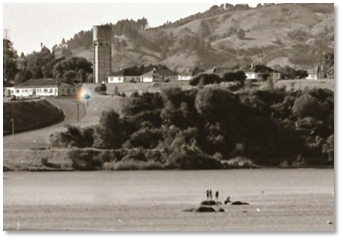Te Ihingarangi – Part 6
-
Part 6 of a history of the Karapiro-Maungatautari area by Te Kaapo Clark and Lyn Tairi.
1800
KO NGATI RAUKAWA, NGATIKOROKI, NGATI WAIRERE, NGATI HAUA
While no Pākehā had set foot in the Maungatautari/ Karapiro region until the 1830s, their presence in Aotearoa was felt there in the 1820s. The introduction of muskets to the Nga Puhi caused a great upheaval in the settlement patterns of the North Island.
Te Rauparaha, whose mother was of Ngāti Raukawa, from Maungatautari, was driven from his home at Kawhia by Waikato and Ngāti Maniapoto after many battles with these tribes. In 1822 Te Rauparaha persuaded his Ngāti Raukawa kin from Maungatautari to join his migration south “because he needed more fighting men.” Ngāti Kauwhata also went with their Ngāti Raukawa cousins.”
The vacant slopes of the mountain were soon filled by tribes from Hauraki. They had been driven from their homelands by Nga Puhi raiders, led by Hongi Hika, The Nga Puhi possessed muskets and were quickly able to defeat their foe who did not. The Ngāti Marutuahu (Maru) built 15 pa between Tauwhare and Maungatautari. One of the largest was Haowhenua — the kainga vacated by Ngāti Raukawa. Ngāti Maru enlarged and fortified the site. Its area covered 15 acres and held “three thousand … warriors … [with] a proportionate number of women and children, old men and slaves.”
Ngāti Haua and Ngāti Koroki had allowed the refugees to settle, but “Ngāti Marutuahu’s aims [soon] became starkly apparent. Behaving like the proverbial cuckoos in the nest they began to plunder friendly neighbouring villages…. Soon murders, skirmishes, pitched battles and massacres became almost daily events, neither side gaining any marked advantage.”
All this culminated in the Battle of Taumatawiwi in December 1830, where Te Waharoa of Ngāti Haua was able to defeat the Ngāti Maru with his superior military skill and the help of one thousand Ngaiterangi warriors from Tauranga. After peace was sued for, the Ngāti Maru were escorted out of the Waikato and then sent home to Hauraki. Te Waharoa “then entrusted the kindred Ngāti Koroki tribe with the guardianship of the mountain and returned to Matamata.”
It is from the Battle of Taumatawiwi that Karapiro gets its name. Kara means rocks and piro means smell or odour. After the battle Te Waharoa was worried about a counter attack from the Ngāti Marutuahu, so that night he burnt the bodies of his dead warriors “lest they fall into the enemy’s hands” — which would indeed cause a very strong smell. This took place on a large outcrop of rocks, near the edge of the river. Most were flooded when the dam was built. Then in 1975 they were removed to make way for the rowing course for the 1978 world rowing championships. One rock is now situated at Maungatautari Marae and the others at Karapiro Domain.

The rocks at Karapiro in 1966.
